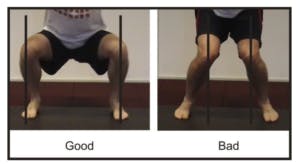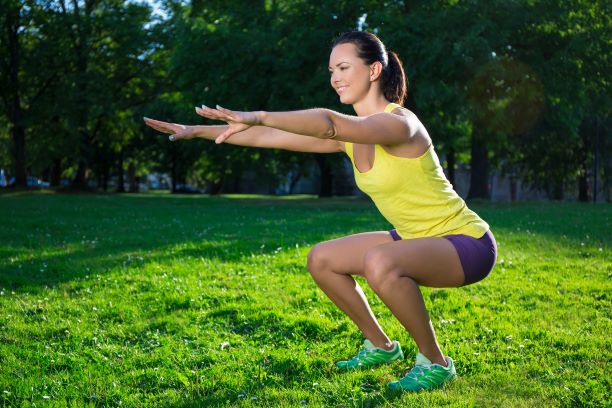Many people avoid squatting because of knee pain. However, when done correctly, or with a few easy modifications, just about anyone can squat without pain. The key is to squat with a hip dominant strategy, instead of quad dominant strategy. This article shows you how to squat without knee pain.
What is a Hip Dominant Squat?
A hip dominant squat takes advantage of your very strong gluteus maximus muscles. This can be done by “sitting back” into your squat. “Sit back” as if you are sitting into a low chair. Your hips move back while your trunk moves slightly forward. Your spine stays straight. Bend at your hips with your chest up. Your knees stay behind your toes. This reduces forces and pain through your knees.

This differs from a quad dominant squat. With a quad dominant squat your trunk remains straight. Also, your knees track forward past your toes. This decreases demands on your glutes and increases demands on your quadriceps. As a result, compressive forces through your knees are increased. So to avoid knee pain, you want to squat with a hip dominant strategy.
The Importance of Your Glutes During the Squat
Your gluteus medius is a thick muscle on the outer part of your pelvis. It spans from your buttock to the upper part of your thigh on your outer hip. The primary function of the gluteus medius is to stabilize your pelvis during dynamic activities such as walking or performing a deep squat. It prevents the opposite side of your pelvis from dropping during walking. The gluteus medius packs many short muscle fibers together. This allows it to generate very high forces. However, a trade-off to its structure is its inability to produce large forces when in lengthened positions.

Your gluteus medius is lengthened when your hips flex and internally rotate. This causes your knee to cave inward during the squat. This movement strategy is called, dynamic valgus. When this occurs your gluteus medius is unable to accomplish its primary role of stabilizing your pelvis. Hip internal rotation during the squat also impairs the ability of your gluteus maximus to extend your hip. However, the hamstrings and adductors can often overcome this deficit to compensate. If you squat with your hip internally rotated this is likely a compensation for weakness of your glutes. You want to do something about this, especially if you are having knee pain.
Banded Squats
An easy way to correct dynamic valgus and avoid knee pain is to squat with bands around your thighs. The resistance band should be tight and placed just above your knees. Throughout the squat pull the band apart. Exaggerate this! The band is a cue to activate your glutes. You really want to pull your knees apart hard to activate your glutes. Also remember to “sit back” into your squat.

Gluteus Medius & Injury
Squatting with hip internal rotation is linked to knee pain and anterior cruciate ligament (ACL) injury. Other injuries that are characteristic of this pattern include runner’s knee, iliotibial band (ITB) syndrome, labral injuries and hip impingement. In many cases, this pattern is a compensation for hip weakness. To strengthen the muscles that control hip internal rotation read this article.
Lifestyle Factors Contributing to Gluteus Medius Weakness

Gluteus medius weakness can be from previous injury or lifestyle factors. Standing with your body weight predominantly on one leg with your pelvis swayed sideways leads to an underdeveloped muscle on one side. Sleeping on one side with your top leg bent and crossed over the other leg results in an elongated muscle. Both of these scenarios weaken the muscle over time. Repeated running on crowned roads leads to weakness of your gluteus medius on one side.
Final Thoughts on Squatting without Knee Pain
Using a hip dominant strategy and avoiding dynamic knee valgus are 2 easy ways to decrease knee pain during the squat. Practice banded squats and emphasize “sitting back with each rep. Also, perform hip strengthening exercises targeting your gluteus medius and maximus. If you are looking for more help, call to schedule an appointment with one of our doctors of physical therapy. We are here to help you move without pain.

